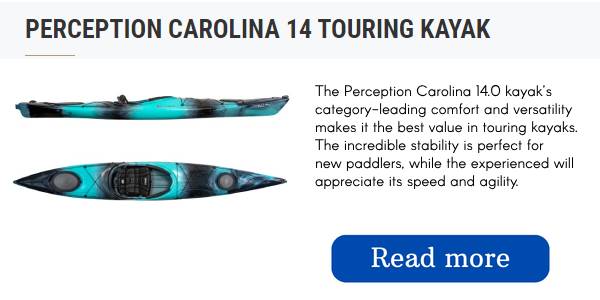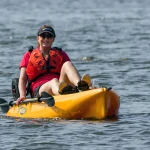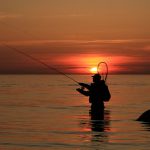If you are asking whether it is better to pedal or paddle a fishing kayak, then you’re probably coming from one of three places:
- You’re new to kayak fishing and want to learn about the difference between pedal and paddle kayaks,
- You use a motorboat for fishing but are considering alternatives,
- You use a paddle kayak for fishing and wonder if you’d benefit from an upgrade.
I view pedal fishing as akin to traditional fishing where the emphasis is on stealth, casting, and presentation. In this context, a kayak with pedals can be a great advantage because it allows you to move effortlessly and quietly through the water to get into position for a good cast. Paddle fishing, on the other hand, is more like river running where the emphasis is on speed and covering ground. In this context, a kayak with paddles can be a great advantage because it will allow you to move more quickly through the water to get to where the fish are biting. So, which is better? It really depends on what you are looking to get out of your fishing experience. If you want to fish in the traditional sense, then a pedal kayak is probably a better option. If you are looking to cover more ground and move more quickly through the water, then a paddle kayak is probably the better option.
If your priority is fishing, and you see a kayak as simply a means of transportation to get you to the fish, then a pedal kayak is better. If you find kayaking to be fun in and of itself, and fishing is just one of the activities you can enjoy while sitting in one, then it’s better to paddle a fishing kayak.
Recently, after a challenging eight-mile trip across a wave-strewn open ocean, I jumped out of my paddle kayak and proudly stuck my paddle in the sand like a victory flag. A minute later, another paddler crashed into the shore and rolled out of his seat, wheezing as he exclaimed, “That’s it! I’m getting a pedal boat.” Aside from his reaction I was hard pressed to draw distinctions between the two of us, so how to choose the right type of propulsion? I was recently challenged with an 8 mile trip across a wave-strewn open ocean. I completed the trip in a paddle kayak and stuck my paddle in the sand like a victory flag. The other paddler who accompied me on the trip crashed into the shore and rolled out of his seat. He was wheezing as he exclaimed, “That’s it! I’m getting a pedal boat.” I was hard pressed to draw distinctions between the two of us, so it got me thinking about how to choose the right type of propulsion.
We asked Justin Hausner, owner of Fuzzy Guppies paddle shop in upstate New York, for help on the key factors separating paddlers and pedalers.
Choose Your Sport
Paddle kayak fishing is better because it is more versatile, stable, and manoeuvrable. When comparing pedal kayak fishing and paddle kayak fishing, it is easier to see that paddle kayak fishing is the better option. This is because paddle kayaks are more versatile, stable, and manoeuvrable than pedal kayaks.
The question is not which is better, but which is better for you.
Look around you and pay attention to your surroundings. Wherever you are sitting, take a moment to imagine what kind of sport would be played there. Would it be a team sport or an individual sport? What kind of equipment would you need? What kind of physical activity would be involved? Hopefully, this exercise will help you figure out which sport is right for you.
Visualize your upcoming kayak fishing adventure. Perhaps it will be your maiden voyage. (If that’s the case, then you’ll need to use some creativity.)
- Picture yourself loading your kayak onto the roof or bed of your vehicle. What are you thinking about while performing this loading task? How do you feel as you think about it? Are you thinking about the upcoming trip or how much your shoulders are shaking as you lift your boat?
- Now, picture yourself on top of the water. You’ve just launched your kayak and are making your way to the honey hole that will yield fish. As you picture yourself shuttling on top of the water to your pre-determined location, what are you thinking about? Is this a happy time or an anxious one?
- You’ve arrived at your fishing location. What are your first thoughts? Are you happy to finally have that kayak trip over with?
- You spend several hours in and around your fishing spot. What do you think about this time?
- Finally, after a great day on the water, it’s time to head back to shore. You’re tired and have a good journey ahead of you. What do you think about it?
What I want to know is if you enjoy kayaking, not just fishing.
Perhaps you would be happier with a pedal-powered fishing kayak if you find yourself miserable and frustrated when loading your boat on your vehicle and you want to reach your fishing destination as quickly as possible.
If you are excited about being able to kayak both to and from your fishing spot, then you may benefit from a more traditional paddle-powered kayak.
Now that we have finished the thought exercise, let’s discuss what is important when kayak fishing.
This discussion has brought us back to the original question: do you want to pedal kayak fish or paddle kayak fish?
We have discussed the features, benefits, pros, and cons of pedal and paddle fishing kayaks. Some kayaks have a pedaling system that helps you move through the water. Other kayaks have a paddle that you use to move through the water. Each type of kayak has its own set of advantages and disadvantages.
A pedal kayak might be a good choice if you want to be able to fish from a non-motorized vessel and access locations that aren’t available to a motorboat.
Pedal fishing kayaks are a great way to get to your fishing honey hole quickly. You can take almost as much gear as you did in your motorboat and do so at a price point that is lower than maintaining a motorboat.
If you’re mainly interested in fishing, then you’ll be more effective if you use a pedal fishing kayak.
Consider the Speed
Pedaled kayaks are usually faster than paddled ones in open water.
I have written a couple of articles discussing how far one can kayak in a day and how to increase kayak speed.
Based on a 9-foot kayak water line, a paddler should be able to glide across the water at about 3.1 miles per hour if they are exerting 67% of their maximum effort.
The farther the water line is, the higher the maximum speed is, but the more strength that is required to reach that maximum.
The kayak fishing website Kayakanglermag.com held an event they called the “Ultimate Fishing Kayak Olympics” in order to compare the performance of different kayaks. The kayaks were put through a series of challenges to test their abilities.
The task was to pedal fast, and the fastest boats scored top speeds of over four miles per hour, which is faster than the average paddler’s significant but non-max effort.
The kayaks are designed to move quickly on the water’s surface without the person pedaling them getting too sweaty.
Pedaled kayaks are faster than paddled kayaks.
Can someone who is super fit and muscular paddle a boat faster than someone who is skinny and sits at a desk all day? Sometimes.
However, this is usually not the norm.
If you need to travel a long distance across a large body of water or several smaller lakes to reach your favorite fishing spot, you might prefer a pedal kayak, unless you enjoy paddling.
Paddle fishing kayaks are usually slower than pedal kayaks once they’re on the water, but it’s faster to get them into the water in the first place.
Here’s what I mean.
After you take your fishing kayak down from the roof of your car, you have to carry it and the pedal unit to where you’re going to start paddling.
, usually the process is quicker and easier on shore. After getting to the starting point, you need to put the pedal unit in the fishing kayak. You can do this while you’re on the water for some boats, but it’s usually quicker and simpler to do it while you’re onshore.
After you install the device, you must go into deep enough water so the propeller or fins don’t touch the ground or any debris on the beach.
This can be time-consuming and slightly annoying.
Paddle fishing kayaks typically require more time to transport, assemble, and push off than pedal fishing kayaks.
Ask A Pro: Paddle Or Pedal?
I ask customers where they fish to determine what kind of kayak to recommend, says Hausner. For example, if they fish in rivers or shallows, he recommends a paddle kayak because there are a lot of weed-choked lakes that can only be accessed in a paddle kayak.
A pedal kayak is better suited for open water and long distance travel. They are more stable to fish in and can carry more gear. Pedal kayaks also instill confidence in the user.
After Hausner inquirers about the customer’s storage and transport options, he states that a paddle kayak is easy to lift onto the top of a car. For quick trips and hard-to-reach fishing spots, a paddle kayak is more ideal.
Who Should Choose A Pedal Kayak?
To me, pedal boats are the way to go because they are easier to use, can carry more stuff, and are more stable and powerful. This makes the person operating the boat feel more confident. On the other hand, paddle kayaks are lighter and have fewer parts that can move, making them simpler.
What finally made me see the appeal of pedal power was an affair I had while kayak fishing in Mexico Beach, Florida with the Hobie team. I tried out a bunch of different models while we were there, from the Outback to the Pro Angler, and I was really impressed with how stable and efficient they all were. I have to admit, pedal kayaks are a great way to get around.
I can get in a pedal kayak, turn the cranks and go anywhere. Pedal kayaks are designed to make efficient use of propellers and fins. The results were evident in the Pedal Boat Olympics. If you’re into kayak fishing just for the fishing, then a pedal kayak, or one of the new motorized models, maybe a perfect choice.
Who Should Choose A Paddle Kayak?
If you like kayak fishing because you enjoy kayaking, then the paddle is an important part of that. I love my paddle because it’s very light and also very strong. I love my kayak because it cuts through the water silently and beautifully. I can go from the truck to the water in less than 10 minutes and paddle through shallow water without any problems. My kayak is designed to launch and recover through the surf without any difficulty, and it can also spin around quickly and stop abruptly if necessary.
A paddle kayak may not be the fastest option for a long-distance event, but it can help you save time by cutting down the distance.
I recently went on a trip with two friends who were pedaling. We left at almost the same time, but they had to pedal around shallow shoals while I was able to cut across the shoreline. This allowed me to reach our destination first, but they had to deal with a headwind.
Setting Priorities and Planning Ahead
The guy wheezing at the boat ramp is not interested in the excitement of paddling. He purchased a large, wide paddle kayak because he was worried about stability. The boat was fine for him in the farm pond back home, but it did not work well in open water. He does not need a pedal kayak, he just needs the right paddle boat for the conditions.
According to Kevin Whitley, a long-distance paddler and kayak specialist, paddle and pedal fishing are two completely different sports that require different skillsets. Many pedal kayakers, Whitley has noticed, are motorboaters who are primarily looking for a stable platform to fish from that can also carry all their gear, rather than anything else. Cost is often a deciding factor for pedal kayakers, as they tend to be more expensive than regular kayaks.
Whitley says that people who paddle are more interested in the simple act of paddling and the experience that comes with it. All you need, he says, is a boat, a paddle, and a life jacket, and you’re good to go. Paddlers don’t have to worry about breaking their rudders or stripped gears.
While Whitley is mostly horror-struck by people who think paddle kayaks are old-school, he is also a little bit frustrated with those who say that pedal boats are only for serious anglers. Whitley believes that many serious anglers choose to paddle because they want to avoid any type of mechanical breakdown, increased weight, or increased draft.
The Choice Is Yours
This is a great time to be a kayak fisherman because there are so many different types of kayaks to choose from that are suited for different types of environments and fisherman. I’m lucky to have found the perfect kayak for the type of fishing I do, but there’s also a perfect kayak out there for every other fisherman, no matter their skill level.




